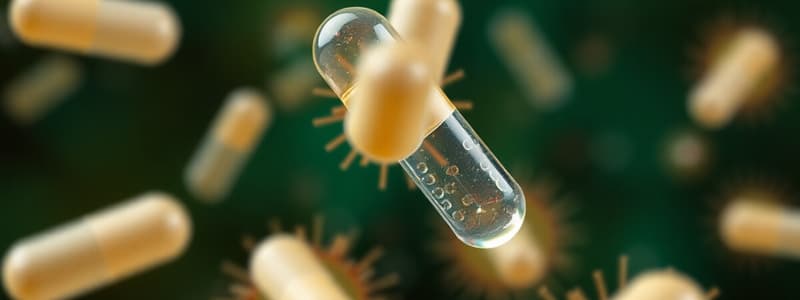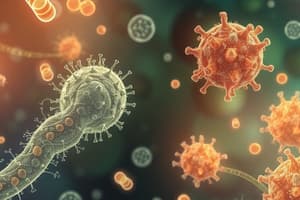Podcast
Questions and Answers
Who first discovered that Staphylococcus aureus could not grow near the mold Penicillium notatum?
Who first discovered that Staphylococcus aureus could not grow near the mold Penicillium notatum?
- Howard Florey
- Alexander Fleming (correct)
- Ernst Chain
- Pfizer
What year did Pfizer achieve mass production of Penicillin using deep-tank fermentation techniques?
What year did Pfizer achieve mass production of Penicillin using deep-tank fermentation techniques?
- 1942 (correct)
- 1950
- 1945
- 1940
What was the yield of wild-type Penicillium notatum in 1929?
What was the yield of wild-type Penicillium notatum in 1929?
- 100-150 units/mL
- 2-20 units/mL (correct)
- 40-80 units/mL
- 80-100 units/mL
Which strain of Penicillium was found to produce 100 times more penicillin than the original strain?
Which strain of Penicillium was found to produce 100 times more penicillin than the original strain?
Which event occurred in 1945 regarding Penicillin?
Which event occurred in 1945 regarding Penicillin?
Which type of microorganism is responsible for producing approximately 70% of known antibiotics?
Which type of microorganism is responsible for producing approximately 70% of known antibiotics?
What was the first antibiotic discovered and what organism produced it?
What was the first antibiotic discovered and what organism produced it?
How many known antibiotics are there approximately?
How many known antibiotics are there approximately?
In the context of antibiotic resistance, which statement is true?
In the context of antibiotic resistance, which statement is true?
What is the significance of antibiotic resistance in microorganisms?
What is the significance of antibiotic resistance in microorganisms?
What is the mechanism through which MRSA effectively resists methicillin?
What is the mechanism through which MRSA effectively resists methicillin?
Which factor contributed to the emergence of resistance to penicillin in Staphylococcus aureus?
Which factor contributed to the emergence of resistance to penicillin in Staphylococcus aureus?
In which year did Staphylococcus aureus first show resistance to methicillin after its introduction?
In which year did Staphylococcus aureus first show resistance to methicillin after its introduction?
What is a principal reason MRSA is now resistant to many antibiotics?
What is a principal reason MRSA is now resistant to many antibiotics?
How did the bacterial resistance to antibiotics primarily evolve?
How did the bacterial resistance to antibiotics primarily evolve?
What is the primary purpose of the Disk-Diffusion Method in drug discovery?
What is the primary purpose of the Disk-Diffusion Method in drug discovery?
Which term describes the process when the combined effect of two drugs is less than the effect of either drug alone?
Which term describes the process when the combined effect of two drugs is less than the effect of either drug alone?
What is the role of potassium clavulanate in antibiotic treatment?
What is the role of potassium clavulanate in antibiotic treatment?
What type of antibiotics are referred to as bactericidal?
What type of antibiotics are referred to as bactericidal?
Which of the following approaches was used for strain selection in 1970?
Which of the following approaches was used for strain selection in 1970?
What is one form of misuse of antibiotics that can lead to antibiotic resistance?
What is one form of misuse of antibiotics that can lead to antibiotic resistance?
Which type of penicillin is designed to have a broader range of activity?
Which type of penicillin is designed to have a broader range of activity?
What is a significant consequence of using antibiotics in animal feed?
What is a significant consequence of using antibiotics in animal feed?
Flashcards
What are Antibiotics?
What are Antibiotics?
Compounds produced by microorganisms that kill or inhibit the growth of other microorganisms.
Streptomyces Bacteria
Streptomyces Bacteria
A genus of bacteria that produces 70% of known antibiotics.
Penicillin
Penicillin
The first discovered antibiotic, produced by the fungus Penicillium notatum.
Antibiotic Resistance
Antibiotic Resistance
Signup and view all the flashcards
Number of Known Antibiotics
Number of Known Antibiotics
Signup and view all the flashcards
Penicillin Discovery
Penicillin Discovery
Signup and view all the flashcards
Penicillin Purification
Penicillin Purification
Signup and view all the flashcards
Penicillin Production
Penicillin Production
Signup and view all the flashcards
Penicillin Nobel Prize
Penicillin Nobel Prize
Signup and view all the flashcards
Strain Improvement
Strain Improvement
Signup and view all the flashcards
Antibiotic Discovery Timeline
Antibiotic Discovery Timeline
Signup and view all the flashcards
Initial Screening for Antibiotics
Initial Screening for Antibiotics
Signup and view all the flashcards
Antibiotic Spectrum
Antibiotic Spectrum
Signup and view all the flashcards
Disk-Diffusion Method
Disk-Diffusion Method
Signup and view all the flashcards
Bactericidal vs. Bacteriostatic
Bactericidal vs. Bacteriostatic
Signup and view all the flashcards
Synergism & Antagonism
Synergism & Antagonism
Signup and view all the flashcards
Causes of Antibiotic Resistance
Causes of Antibiotic Resistance
Signup and view all the flashcards
What is MRSA?
What is MRSA?
Signup and view all the flashcards
How did MRSA evolve?
How did MRSA evolve?
Signup and view all the flashcards
How does Methicillin work?
How does Methicillin work?
Signup and view all the flashcards
What is Beta-Lactamase?
What is Beta-Lactamase?
Signup and view all the flashcards
Why is antibiotic overuse a problem?
Why is antibiotic overuse a problem?
Signup and view all the flashcards
Study Notes
Course Information
- Course code: MICR20010
- Course title: Agricultural Microbiology
- Instructor: Dr. Tadhg Ó Cróinín
Exam Schedule
- Practical Exam: November 22nd, 2-3 PM. 30 multiple-choice questions (MCQs) over 1 hour. Focuses on practical material (manual and online). Worth 15% of the final grade.
- Final Exam: December 12th, 9:30-11:30 PM. Confirm time on official schedule. 60 MCQs over 2 hours. Questions will cover lecture material. Worth 70% of the final grade.
- Practice materials for both exams are available on Brightspace.
Remaining Lectures
- Lecture 10: Microorganisms and Disease
- Lecture 11: The Immune System
- Lecture 12: Pathogenic Bacteria
- Lecture 13: Pathogenic Fungi and Viruses
- Lecture 14: Antibiotic Resistant Microorganisms
- Lecture 15: Microbiology in the Food Industry - The Fungi
- Lecture 16: Microbiology in the Food Industry - Fermentations
- Lecture 17: The Nitrogen Cycle
Antibiotic Discovery and Resistance
- What are Antibiotics?
- Compounds produced by microorganisms.
- Kill or inhibit the growth of other microorganisms.
- Approximately 70% are produced by Streptomyces bacteria
- Penicillin was first and produced by Penicillium notatum
- Approximately 8000 known antibiotics.
- Discovery of Penicillin:
- 192: Alexander Fleming discovered that the bacterium Staphylococcus aureus failed to grow in areas contaminated by Penicillium notatum.
- 1940: Howard Florey and Ernst Chain purified penicillin, injected into mice, and initiated human trials.
- 1942: Pfizer achieved mass production of Penicillin using deep-tank fermentation techniques.
- 1950: Penicillin was available orally to the public without a prescription.
- 1945: Nobel Prize in Physiology & Medicine jointly awarded to Fleming, Florey, and Chain for the discovery of Penicillin.
Antibiotic Producing Organisms
(Table 30.2)
- Various microorganisms, including bacteria (e.g., Bacillus licheniformis, Streptomyces species), fungi (e.g., Cephalosporium spp., Penicillium griseofulvin), and actinomycetes, produce antibiotics.
Development of Penicillin Strains
- The original Penicillium mould (notatum) produced much less penicillin (less than 10 units per mL of broth) in 1943.
- A new strain, Penicillium chrysogenum, produced 100 times more penicillin.
- Strain improvement continued over the next 30 years.
Industrial Evolution of Penicillin Production
- Various methods and developments in penicillin production are detailed, showing increases in yield over time.
Drug Discovery
- A method of initial strain screening is described.
Check Antibiotic Spectrum
- A method of determining antibiotic efficiency on different microorganisms
- Streaking a sample of suspected antibiotic-producing microorganisms and testing for the zone of growth and inhibition.
Disk-Diffusion Method
- Use of the Disk-Diffusion Method for identifying effective antibiotics.
Testing a Strain - Examples
- Staphylococcus albus
- Micrococcus luteus
The Action of Antimicrobial Drugs
- Bactericidal: Directly kills microbes.
- Bacteriostatic: Prevents microbes from growing.
Effects of Drug Combinations
- Synergism: Combined drug effect is greater than individual drug effects. Example: Combination of penicillin with potassium clavulanate (inhibitor of penicillinase). This combination with broad-spectrum penicillin - amoxicillin is Augmentin.
- Antagonism: Combined drug effect is less than individual drug effects.
Synergism between Two Different Antibiotics
- Demonstrated visually by the effect of two different antibiotics on the growth of specific microorganisms.
- Shows antibiotic synergy, resulting in a larger zone of inhibition.
The Action of Antimicrobial Drugs: Mechanism of Action
- Cell wall synthesis
- Protein synthesis inhibition
- Nucleic acid replication inhibition
- Plasma membrane injury
- Essential metabolite synthesis inhibition
Inhibitors of Cell Wall Synthesis - example: Penicillin
-
Naturally occurring penicillins.
-
Semisynthetic penicillins (improved from natural forms, overcoming weaknesses).
-
Extended-spectrum penicillins (effective against a broader range of bacteria).
-
Penicillin G (requires injection).
-
Penicillin V (taken orally).
However...
- A cartoon about bacteria developing resistance to penicillins.
Antibiotic Resistance
-
Misuse of antibiotics selects for resistant mutants.
-
Includes factors like outdated antibiotics, using them inappropriately, or not completing a full course.
-
Using antibiotics in animal feed.
Antibiotics and Animal Feed
- Data shows a correlation of increasing resistance to antibiotics in poultry by use in animal feed over time.
Resistance to Penicillin
- Gene for beta-lactamase (an enzyme that breaks down penicillin) carried by plasmids.
- Methicillin introduced, relatively resistant to beta-lactamases.
- Methicillin-resistant Staphylococcus aureus (MRSA) is a consequence
The Evolution of Drug-Resistant Bacteria
- Staphylococcus aureus (commonly found on people).
- MRSA (methicillin-resistant S. aureus) is a serious pathogen.
- S. aureus resistance to penicillin emerged within two years of its widespread use.
- Resistance to methicillin emerged shortly after its widespread use.
Methicillin
- Methicillin mechanism for inhibiting bacteria.
- Different protein used by MRSA strains.
- MRSA strains' higher survival rate compared to non-resistant S. aureus strains when exposed to methicillin.
- Current resistance to multiple drugs in the MRSA strain.
Resistance Mechanisms
- Mechanisms of resistance to antibiotics: Blocking entry, inactivation of enzymes (eg: beta lactamases), altering the target molecule, and efflux.
Finding new Antibiotics
- Teixobactin, a new discovery, signals a new antibiotic class.
- Importance in finding new ways to combat resistance.
- Exploring new environments for discovering new antibiotics.
Next Time:
- Microbiology in the food industry, Part 1: The Fungi
Studying That Suits You
Use AI to generate personalized quizzes and flashcards to suit your learning preferences.





